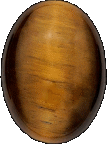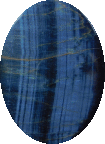| |
Tigereye
|
Tigereye is a pseudomorph of rock asbestos where the crocidolite fibers that have undergone mineral replacement with silica. When light refracts across these thin fibers of quartz it causes an eye that dances across the surface of the cabochon. This optical effect is called chatoyancy, from French meaning cat’s eye.
There are three main colors in which tiger eye is commonly found in the market today. The golden tigereye is the color most commonly encountered in jewelry. The blue variety is called hawk's eye, it possesses much of the original color of the crocidolite. The red is called bull's eye, though much of this material is heat treated.
The name tigereye is a relatively recent phenomena, dating to the 1800s when the material was first isolated as a separate gem. Most of the older texts group all chatoyant stones under the name cat’s eye, not just our modern chrysoberyl.
Some of the early lapidaries have proposed that the cat’s eye was the stone set into the Ring of Gyges. This was a mythic ring that was discovered by a shepherd in a cognitive experiment purposed by Plato. This ring had the ability to turn the wearer invisible when they turned the band around so the stone faced the palm of the hand. Plato and Socrates used the story to argue about the nature of man.
Many of the early lapidaries bestowed upon the cat’s eye the ability to bring good luck, protect from the evil eye, and break enchantments.
|
Colors
|
Gold, Red, Blue, various colors in between
|
Locations
|
Africa, Australia, Brazil, Canada, China, India, and the USA
|
Compisition
|
NaFe(SiO3)2
|
Hardness
|
6 - 7
|
|

|

|

|
|
|
|
|
|